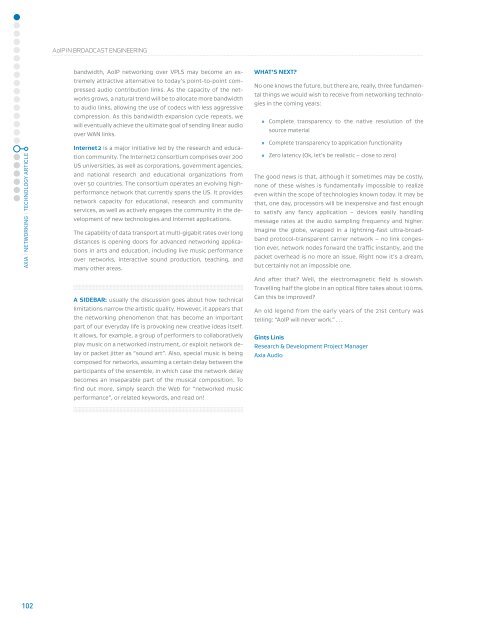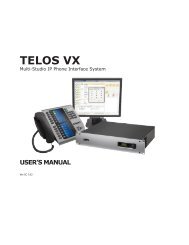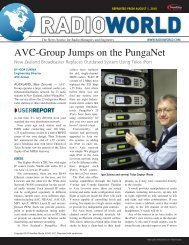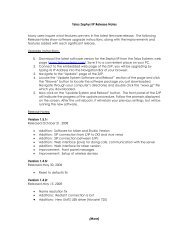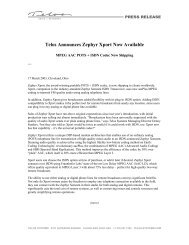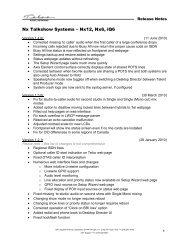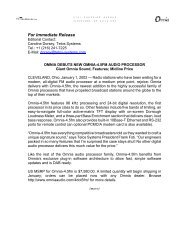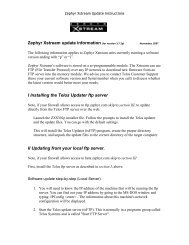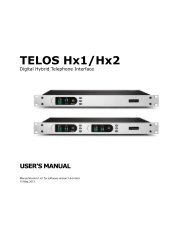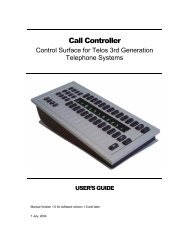NOW! 12-13 - Telos
NOW! 12-13 - Telos
NOW! 12-13 - Telos
Create successful ePaper yourself
Turn your PDF publications into a flip-book with our unique Google optimized e-Paper software.
AXIA | NETWORKING | TECHNOLOGY ARTICLE<br />
102<br />
AoIP IN BROADCAST ENGINEERING<br />
bandwidth, AoIP networking over VPLS may become an extremely<br />
attractive alternative to today’s point-to-point compressed<br />
audio contribution links. As the capacity of the networks<br />
grows, a natural trend will be to allocate more bandwidth<br />
to audio links, allowing the use of codecs with less aggressive<br />
compression. As this bandwidth expansion cycle repeats, we<br />
will eventually achieve the ultimate goal of sending linear audio<br />
over WAN links.<br />
Internet2 is a major initiative led by the research and education<br />
community. The Internet2 consortium comprises over 200<br />
US universities, as well as corporations, government agencies,<br />
and national research and educational organizations from<br />
over 50 countries. The consortium operates an evolving highperformance<br />
network that currently spans the US. It provides<br />
network capacity for educational, research and community<br />
services, as well as actively engages the community in the development<br />
of new technologies and Internet applications.<br />
The capability of data transport at multi-gigabit rates over long<br />
distances is opening doors for advanced networking applications<br />
in arts and education, including live music performance<br />
over networks, interactive sound production, teaching, and<br />
many other areas.<br />
A SIDEBAR: usually the discussion goes about how technical<br />
limitations narrow the artistic quality. However, it appears that<br />
the networking phenomenon that has become an important<br />
part of our everyday life is provoking new creative ideas itself.<br />
It allows, for example, a group of performers to collaboratively<br />
play music on a networked instrument, or exploit network delay<br />
or packet jitter as “sound art”. Also, special music is being<br />
composed for networks, assuming a certain delay between the<br />
participants of the ensemble, in which case the network delay<br />
becomes an inseparable part of the musical composition. To<br />
ind out more, simply search the Web for “networked music<br />
performance”, or related keywords, and read on!<br />
WHAT’S NEXT?<br />
No one knows the future, but there are, really, three fundamental<br />
things we would wish to receive from networking technologies<br />
in the coming years:<br />
» Complete transparency to the native resolution of the<br />
source material<br />
» Complete transparency to application functionality<br />
» Zero latency (Ok, let’s be realistic – close to zero)<br />
The good news is that, although it sometimes may be costly,<br />
none of these wishes is fundamentally impossible to realize<br />
even within the scope of technologies known today. It may be<br />
that, one day, processors will be inexpensive and fast enough<br />
to satisfy any fancy application – devices easily handling<br />
message rates at the audio sampling frequency and higher.<br />
Imagine the globe, wrapped in a lightning-fast ultra-broadband<br />
protocol-transparent carrier network – no link congestion<br />
ever, network nodes forward the trafic instantly, and the<br />
packet overhead is no more an issue. Right now it’s a dream,<br />
but certainly not an impossible one.<br />
And after that? Well, the electromagnetic ield is slowish.<br />
Travelling half the globe in an optical ibre takes about 100ms.<br />
Can this be improved?<br />
An old legend from the early years of the 21st century was<br />
telling: “AoIP will never work.” …<br />
Gints Linis<br />
Research & Development Project Manager<br />
Axia Audio


